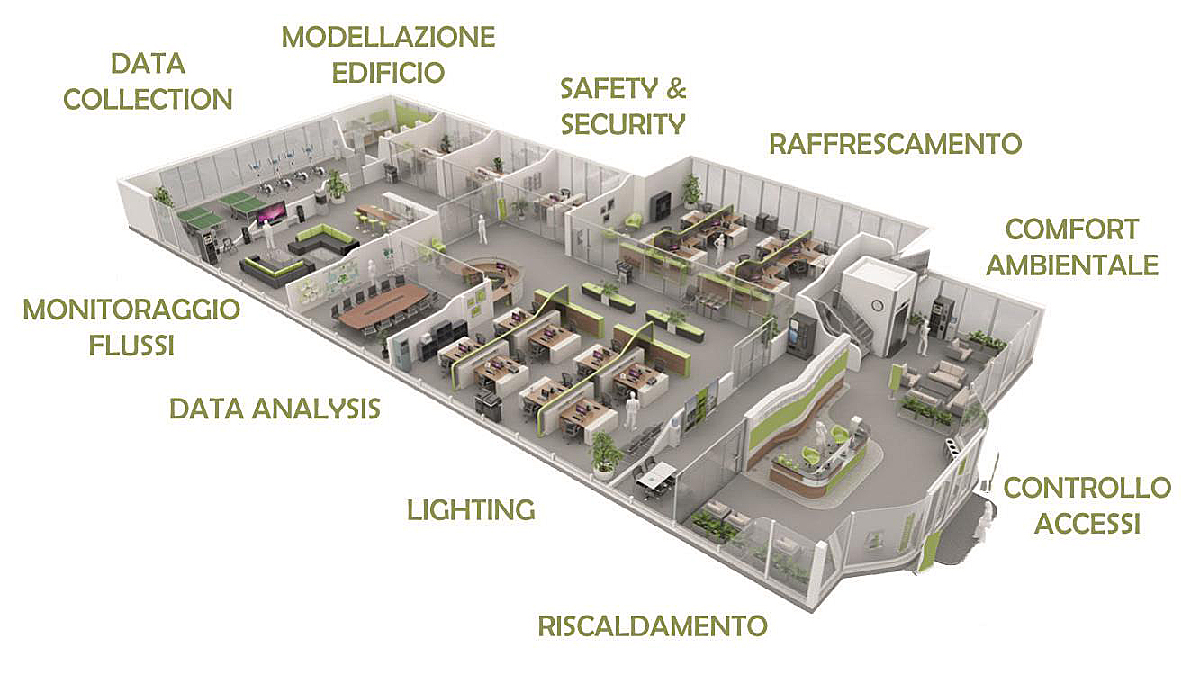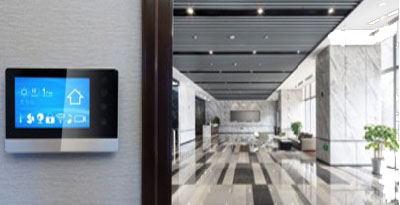The SAMBA (Smart and Advanced Multitenant Buildings Automation) project is funded by the Lombardy Region’s POR FESR 2014-2020 programme and won the 2019 Call Hub, proposed to transform existing buildings into smart buildings using economical, low-impact solutions that deliver maximum performance.
Thanks to non-invasive technologies based on the latest IoT and 5G sensors, buildings will be able to self-learn (machine learning) and consequently automatically activate their functions (lights, heating, cooling, security and access), providing users with maximum environmental comfort and security, and optimising the use of the structure.
The project consortium, comprising Harpaceas, 3P Technologies, Kalpa, ATS, Eucentre and Agevoluzione, brings together innovative companies and research institutions to ensure cross-cutting and complementary expertise.
Purpose
SAMBA Has developed a system that can learn how an existing building is used and model its behaviour using artificial intelligence.
The main objective was to integrate the systems that make up the intelligent building, such as energy management and consumption, audio-visual equipment management and control, and security. These systems will then be able to communicate with each other automatically through a supervisory and control infrastructure, as well as a remote building control system based on behavioural learning.
Eucentre’s contribution focuses on safety, with the aim of monitoring the seismic safety level of non-structural components typical of multi-tenant buildings. SAMBA has selected the Co+FABB complex in Sesto San Giovanni (MI) as a case study for experimentation.
Results
The outcome of the SAMBA project was the creation of a remote autonomous control solution for management of multi-tenant buildings, leveraging artificial intelligence and machine learning.
The tool will be hierarchical according to user type and simple and intuitive to use.
The final product is primarily aimed at multitenant buildings, and then at other types of buildings such as hotels, condominiums, public buildings and shopping centres.
This is a major innovation because it involves the low-cost application of digital technologies to historical buildings, which represent the majority of existing buildings in Lombardy and Italy. The aim is to achieve social, environmental and productive objectives, providing a technological solution that is appropriate to the Italian and Lombard context. This context is characterised by the necessary encounter between history and tradition, on the one hand, and innovation and the digital world, on the other.
Read more:



For more information on the project, please fill out the following request form:
 Eucentre is a non-profit private law foundation whose mission is to conduct research and provide training and services in earthquake and safety engineering
Eucentre is a non-profit private law foundation whose mission is to conduct research and provide training and services in earthquake and safety engineering  Eucentre promotes science, research and innovation for the benefit of the community, offering targeted methodologies and concrete solutions for prevention, safety and resilience. It collaborates with institutions and companies to disseminate competencies for the common good.
Eucentre promotes science, research and innovation for the benefit of the community, offering targeted methodologies and concrete solutions for prevention, safety and resilience. It collaborates with institutions and companies to disseminate competencies for the common good. Shake-tables
Shake-tables Other test systems
Other test systems Eucentre carries out research activities in earthquake engineering and risk reduction through laboratory testing and numerical analysis, aiming to improve the seismic performance of structures and soils and to develop innovative seismic retrofitting techniques.
Eucentre carries out research activities in earthquake engineering and risk reduction through laboratory testing and numerical analysis, aiming to improve the seismic performance of structures and soils and to develop innovative seismic retrofitting techniques. The Foundation promotes diverse and high-quality training activities aimed at academic and professional contexts, with constantly updated and innovative programs and initiatives designed to meet the evolving needs of the sector and society
The Foundation promotes diverse and high-quality training activities aimed at academic and professional contexts, with constantly updated and innovative programs and initiatives designed to meet the evolving needs of the sector and society  Eucentre ensures communication aimed at informing institutions, professionals, and citizens about ongoing activities and projects, with the goal of disseminating useful and accessible content and knowledge. It contributes to promoting a shared and informed culture of prevention and resilience.
Eucentre ensures communication aimed at informing institutions, professionals, and citizens about ongoing activities and projects, with the goal of disseminating useful and accessible content and knowledge. It contributes to promoting a shared and informed culture of prevention and resilience.
